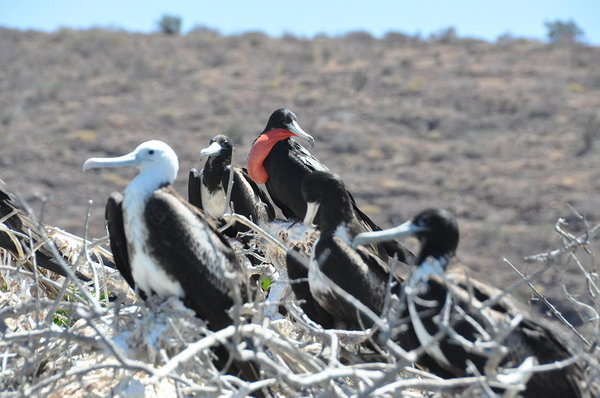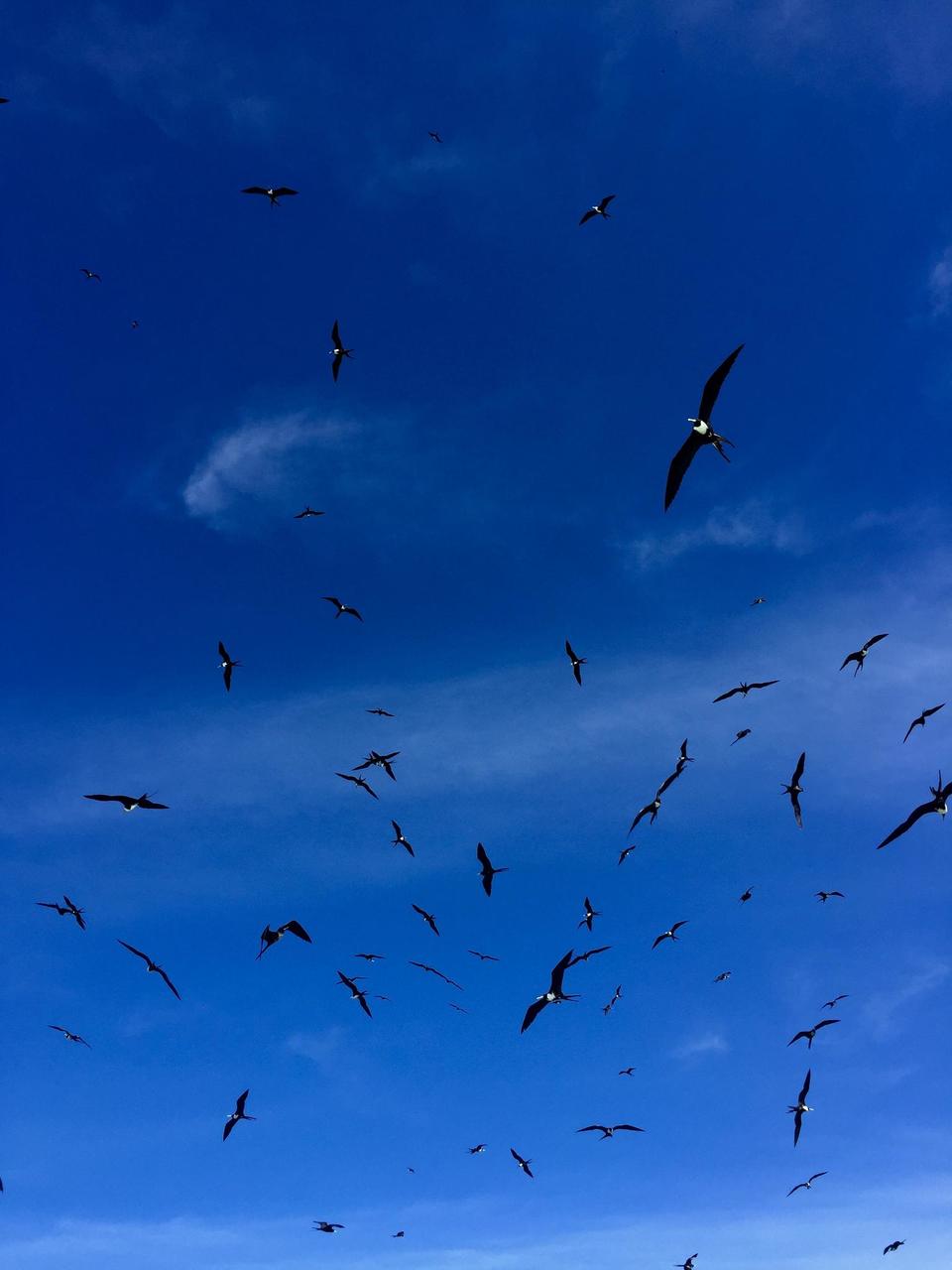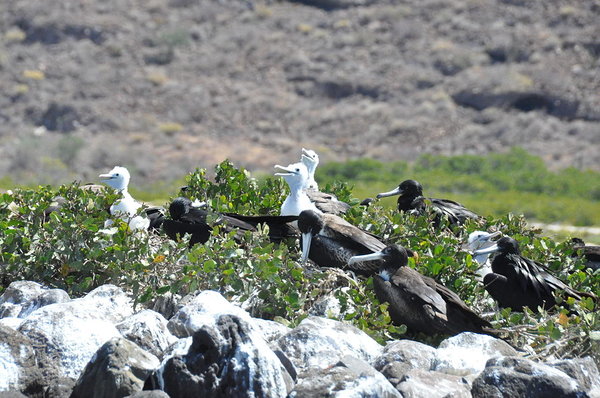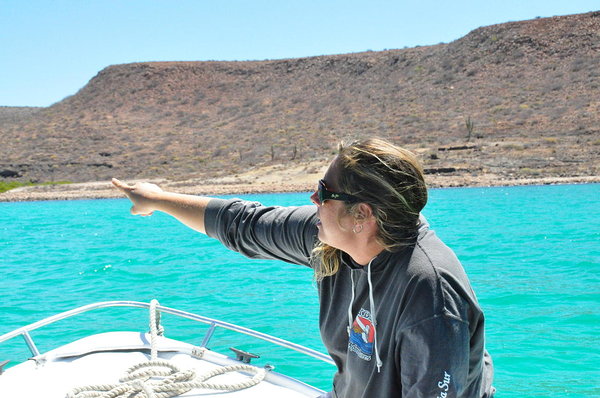Where Angels Sing
The inspiration for this month’s musings came whilst listening to one of my favourite Meatloaf songs (I find it hard to say complete favourite as he has so many good ones; I am a big fan) and looking up at a black speck in the blue sky. That speck happened to be a frigate bird soaring high above me in the thermals. If you come and visit La Paz for a boat charter with us or to wander the city these are one of the birds you will definitely have the pleasure of seeing here at the coast.
Frigate birds or Frigatidae, are seabirds of which there are five different species within the family. I am going to focus on the Magnificent Frigate as it is the one we see most often here in La Paz. Many of you will have seen this bird without knowing it if you have visited the area before – it is often seen high up in the sky and has a very distinctive forked tail, from a distance they appear all black but upon closer inspection there are some colour variations which help us to tell apart the males from the females and the young from the old. The Magnificent Frigate is the largest in the family with a wingspan of 2.1-2.5m and from head to tail 0.8-1.2m. Despite their large size they are incredibly light, weighing only 1.1-1.5kg (2.5-3.5lbs)! They have the largest wing to body weight ratio of any bird and this helps to make them fast and efficient fliers. Frigates can spend days and nights ‘on the wing’ just flying silently; when not in pursuit of prey they fly about 10km/hr (6.2mph) and can cover distances of over 220km before they need to land and rest. To cover these distances so efficiently they climb upto 2500m above sea level and ride the thermal breezes and descend back to sea level to bathe, drink and rest. Aswell as taking advantage of environmental conditions their bodies have been built with a purpose to soar – their bones are filled with air therefore they are ultra light and only comprise about 5% of their body weight. Shoulder joints are exceptionally strong because they are fused to the breast bone. Pectoral muscles are really well developed for strength and can weigh as much as the feathers – about 50% of a frigates weight comes from the feathers and pectoral muscles.
When it comes to eating, frigates are what are known as Pelagic Piscavores – fish eaters of the open sea! Despite this catchy title, they are not diving birds – in fact they can’t even land on water (or regular land for that matter…) this is because their feathers do not produce enough oil to make them waterproof. Frigate will only feed on fish that are right up at the surface and can be caught without touching the water, to take advantage of anything that they see whilst flying,they can dive down to the surface at speeds of 153km/h!. Fisherman know to keep a look out for them as they are often an indicator from afar that there may be a bait ball and dorado around. The dorado herd the fish towards the surface which the frigates can take advantage of and the presence of the birds helps to drive some of the small fish for the dorado to pick off. The other way that they can take food whilst in flight is to be Kleptoparasites; they steal food from other birds. They will chase and intimidate each other and also other bird species into dropping their prey for them to pick up. They have even been known to snatch seabird chicks from the water or their nests – this pillaging behaviour has earned them the nickname piratebirds!
I mentioned earlier that they cannot walk on land, they can only rest on rocky outcrops, branches or posts (sometime sailboat masts will do just the trick too!). This means that they often come together to form colonies of upto 5000 nesting birds. We have a nesting colony at Bahia San Gabriel, one of the earlier bays in Isla Espiritu Santo. We like to include a visit to this bird sanctuary during our trips as it is a spectacular site to see so many of these birds together. Mating pairs are monogamous for the season; the male is all black, you may see purple iridescent feathers on his scapulas as this helps to attract the females, and also a bright red gular sac. This throat pouch is often tucked away but can be inflated to look like a red balloon to help win a mate. The females are usually black but can have brown markings across their back but what identifies them is the white patch on their breasts. These couples will lay just a single egg each season and may only breed every other year due to the high parental investment in that one young keeping them occupied. The young chicks are white all over and the teenage birds have a white head and underside. Due to the size of the colony at San Gabriel it is likely that you will see all four colour and members of the family. If you watch the behaviour closely then you may even see the mating ritual amongst the chattering and soaring. This comprises of the male sitting in one spot within the colony and looking up to the females flying overhead. Their bill will be open, their throat pouch inflated and wings rapidly vibrating, they also produce a drumming sound by vibrating their bills and may even make a whistling call. The female will fly down to her chose male and he holds her bill in a display of affection and ownership whilst she hovers above.
So come on out and enjoy the island, the wildlife above the water can be just as interesting as that below; spending some time looking out for these cool details will enhance your stay and understanding of our beautiful area.



